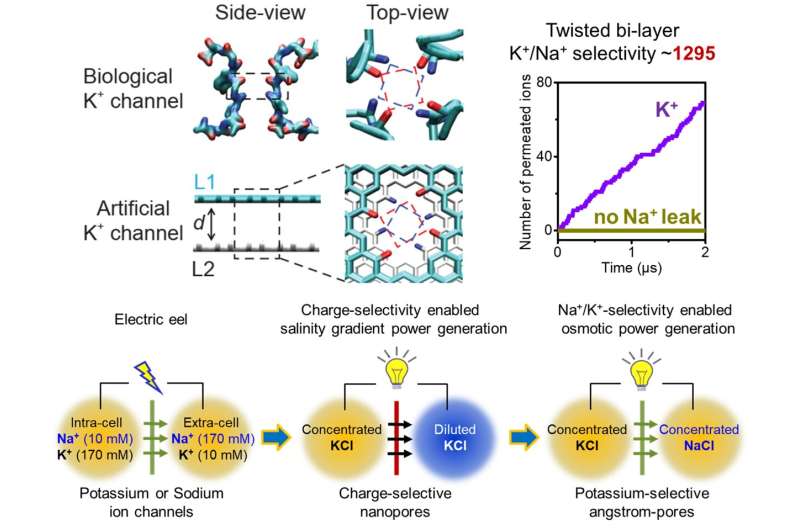This article has been reviewed according to Science X's editorial process and policies. Editors have highlighted the following attributes while ensuring the content's credibility:
fact-checked
trusted source
proofread
Unprecedented artificial potassium channels better mimic those of electric eels

Biological potassium ion channels allow selective permeation of larger K+ (ionic radius of 1.3 Å) over smaller Na+ (1.0 Å) with selectivity ratio over 1,000-fold. For decades, scientists have long sought to mimic these marvels in artificial systems, but have fallen far short of matching the exquisite ion discrimination of natural protein channels. Typically, the K+/Na+ selectivity ratio of existing artificial potassium channels is less than 40-fold.
By revisiting the atomic structure of the 12-Å-long four-fold symmetric tubular selectivity filter of biological KcsA potassium channels, researchers have found that the extraordinary K+/Na+ selectivity originates from four periodic layers of carbonyl ring functioning as the potassium ion binding sites. Of note, the two adjacent carbonyl rings are not strictly overlapped. Instead, there is a nearly 27 degree rotation due to the dihedral angles of amino acids.
The study is published in the journal National Science Review.
The long-overlooked structural feature of the rotary carbonyl rings underpins the ultra-high K+/Na+ selectivity, but has never been utilized in constructing artificial potassium channels.
Following this design principle, the researchers create angstrom-scale pores in bi-layer graphene sheets, and decorate the two pore edges with twisted rings of carbonyl groups. The artificial ion channel can strictly inhibit the transport of unwanted Na+ with dynamic K+/Na+ selectivity ratio up to 1,295-fold. K+ conduction rate approaches 3.5×107 ions/s, which is almost 40% of the biological potassium ion channels.
Atomic trajectories of K+ permeation events unveil a dual-ion transport mechanism, that is, each successful K+ permeation should involve at least two potassium ions.
The release of a K+ from the exit of the bi-layer nanopore is achieved via a soft knock-on mechanism from another K+ at the entrance, which has solely been found in biological ion channels before. The synergetic behavior is facilitated by the one or two hydrate water molecules between the graphene layers, forming so-called K-nH2O-K triplets.
Beyond gaining insight into the working principles of biological systems, highly potassium-selective artificial ion channels enable new applications not found in nature. As a proof-of-concept demonstration, the researchers propose a novel way for harvesting ionic power by mixing electrolyte solutions of equal concentration through the bi-layer angstrom-pores. Theoretically, the biomimetic device achieves a very high power density of over 1,200 W/m2 with graphene sheets of merely less than 1% porosity.
Notably, the potassium-permselectivity enabled osmotic power generation (PoPee-OPG) better mimics the methods of energy conversion by the electrocyte cells of electric eels. First, PoPee-OPG could operate using solutions of equal total ionic strength. This contrasts the indispensable diluted solutions used in existing salinity gradient power generation (SGPG), which limit their performance.
Second, it is worth mentioning that there is actually no apparent low-concentration part in the body fluid of electric eels due to the balance of osmotic pressure across cell membrane. The significant improvement of PoPee-OPG is equivalent to largely reduce the internal resistance of an ionic power source, and thus enables high output power. From this point of view, PoPee-OPG upgrades the electric-eel-mimetic energy conversion.
While still theoretical at this stage, the unique pore structure and working principles found in this article could guide fabrication of highly selective membranes from—for example—stacked graphene-based materials or bi-layer covalent-organic framework components. Overall, the biomimetic design brings the exceptional capabilities of natural proteins into human-engineered devices, and provides a blueprint for versatile applications for water purification, chemical separation, ionic batteries, and so on.
More information: Jipeng Li et al, Designing artificial ion channels with strict K+/Na+ selectivity toward next-generation electric-eel-mimetic ionic power generation, National Science Review (2023). DOI: 10.1093/nsr/nwad260
Provided by Science China Press





















